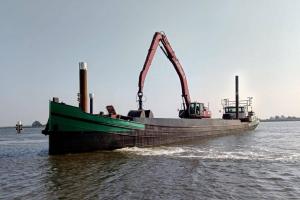In line with the trend of greening inland navigation, CLINSH participant Van der Meulen Woudsend developed the showpiece of its fleet. They converted their 49.50-metre crane ship into a hybrid ship, which now emits 99 percent less soot, 16 percent less CO2 and 98 percent less nitrogen. The conversion was made possible by the European CLINSH project with a subsidy of EUR 150,000.
The MS Triton has been a participant in the CLINSH project since September 2019. The propulsion, bow thruster and crane of the crane ship are now electrically powered. The energy is generated by a diesel generator (PACCAR MX EURO VI+ 440 kVA) that meets the latest Euro VI+ requirements. A spare generator prescribed by the Environment & Transport Inspectorate ensures that failure or malfunction can be absorbed. The conversion of the crane ship took place last spring.
Limited space
The European Union's objective is more sustainable and cleaner navigation on inland waterways. This objective will be achieved by putting emission reductions into practice and making the reduce soot emissions. “With larger ships, conversion is a lot easier, because you then have the space to run the vessels with electric motors”, says owner Mark van der Meulen. He continues: “With relatively small barges, such as our Triton, you have only 50 metres in length to use. That is rather limited, but these ships are indispensable on the Frisian inland waterways”.
About Van der Meulen Woudsend
Van der Meulen Woudsend specialises in the supply and installation of rubble, dredging of canals, lakes and harbours, construction and maintenance of natural banks, Ground transportation and wet earth moving.

